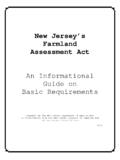Transcription of Measurement of Agricultural output in the …
1 Measurement of Agricultural output in the australian system of national Accounts: methods and issues Brunton, Rick australian Bureau of Statistics 45 Benjamin Way Belconnen ACT 2617 Australia Trickett, Carol australian Bureau of Statistics 45 Benjamin Way Belconnen ACT 2617 Australia Abstract Agriculture gross value added represented 2% of Australia's total Gross Value Added (GVA) in volume terms in 2006-07 but production can vary significantly from year to year in line with variability in weather conditions.
2 As such, measuring Agricultural output is important in assessing Australia s overall annual rate of economic growth in Gross Domestic Product (GDP). Value added for the farm sector is derived using a production approach and is measured in both current price and chain volume terms as gross value of Agricultural production less the costs incurred. For most commodity groups gross value of production is used as the measure of output . The only exceptions are wheat and wool, where a production valuation adjustment is applied.
3 The valuation adjustment is required because the gross value of production for wheat and wool are based on estimated or realised future sales prices, which may be different from average current period prices. Australia collects data on 54 commodity groups in compiling the gross value of Agricultural production. The major commodity groups are livestock, wheat, milk, wool, barley, and sugar. In 2006-07 these accounted for 58% of the total gross value of production. The paper describes the approach used in the australian system of national Accounts (ASNA) to measure the output and value added of the australian Agriculture industry, annually and quarterly.
4 The paper also discusses some of the Measurement issues associated with estimating value added for the Agricultural industry including the allocation of production to the appropriate quarter and the difficulty of seasonal adjustment when production can vary significantly from season to season. 1. Introduction Agriculture Gross Value Added (GVA) represented 2% of Australia's total GVA in volume terms in 2006-07. While 2% is a small proportion, the variability of Australia's Agricultural output from year to year can have a significant impact on Australia's total GVA.
5 For example, Australia is currently experiencing a drought and Agricultural gross value added in volume terms has fallen by 19% in 2006-07 and has made a negative contribution of to Australia's Gross Domestic Product (GDP) volume growth in 2006-07. To put these numbers into context, Australia's GDP grew by in 2006-07. Please purchase PDF Split-Merge on to remove this watermark. Table 1: Contribution of agriculture value added at basic prices to GDP volume growth Year Contribution of agriculture to GDP (% change) GDP volume growth (% change) 2000-01 2001-02 2002-03 2003-04 2004-05 2005-06 2006-07 The graph below shows the growth in agriculture gross value added in chain volume terms from 1974-75 to 2006-07.
6 It highlights the significant impact that droughts in 1982-83, 1994-95, 2002-03 and 2006-07 had on GDP growth. Figure 1: Agriculture gross value added at basic prices A g ric u ltu re G V AC h a in v o lu m e m e a s u re s051 01 52 02 53 01 9 7 4 - 7 5 1 9 7 9 - 8 0 1 9 8 4 - 8 5 1 9 8 9 - 9 0 1 9 9 4 - 9 5 1 9 9 9 - 0 0 2 0 0 4 - 0 5$Billion Please purchase PDF Split-Merge on to remove this The concept of gross value added Gross value added is defined as output less intermediate input costs.
7 output consists of the value of goods and services produced within a producing unit and available for use outside the unit. output includes work-in-progress and finished goods produced during the accounting period that have not been sold and are therefore held in inventories. Intermediate input costs consist of the value of goods and services consumed in the production process, other than depreciation of fixed assets, which is recorded separately as consumption of fixed capital. Intermediate input costs includes the value of goods transformed in the production process, goods and services consumed entirely in the process, and consumption of ancillary services ( accounting, marketing, transportation, storage) within the institutional unit undertaking the production.
8 Australia calculates gross value added at basic prices for the agriculture industry as follows: Figure 2: Calculation of gross value added for the agriculture industry Gross value of Agricultural production Less Intermediate input costs Equals Gross value added at producers prices (commonly referred to as Farm GDP) Less Taxes less subsidies on products Equals Gross value added at basic prices 3. Data sources Australia uses a range of data sources to calculate gross value added for the agriculture industry.
9 Data are collected through both australian Bureau of Statistics (ABS) surveys and other government agencies. ABS data collections The ABS conducts an Agricultural census every five years, with large sample surveys in intervening years. While the census should capture all farm businesses, for practical reasons the scope of the census is restricted to farm businesses above a certain activity cut-off. In the most recent Agricultural census run in 2005-06, around 155,000 farm businesses were in scope of the census representing around 98% of total commodity production.
10 The scope of the Agricultural census / sample survey is restricted to collecting quantity information. Market prices and marketing costs are collected through two separate annual ABS surveys. Market prices are used in combination with the quantities collected from the agriculture census / survey to calculate gross value where gross value represents the value placed on commodities at the point of sale ( in the marketplace). These prices are inclusive of any product taxes paid and any product subsidies received which is a different valuation basis compared with farm gate prices.






